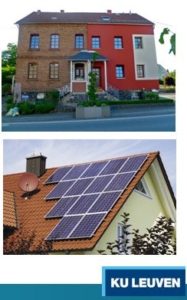Subtask 2 of the IEA EBC Annex71
Annex 71 Subtask 2 “Building Behaviour Identification” focuses on the development of dynamic data analysis methods suitable for describing the energy dynamics of buildings. The aim is to develop models, based on in-situ monitored data that can be used in model predictive control, fault detection and design, control and optimisation of district energy systems. This Subtask will analyse the data acquisition, development of methodologies and accuracy and reliability of the building behaviour identification models for individual dwellings and residential districts. At the same time Subtask 2 will make the link with BES-models (BES: Building Energy Simulation) by performing a BES-validation and calibration exercise.
Subtask 2 consists of three major tasks:
Subtask 2.1 looks into finding case studies that can be used for developing reliable procedures for dynamic data analysis and to perform validation and calibration of BES models on real measured data. Currently the participants are proposing cases in which extensive data sets will be collected, making it possible to investigate the impact of reducing the set of input data on the obtained outcome. That way the minimum amount of data needed for a reliable identification can be defined. The obtained data will also be used in Subtask 3 to develop and validate parameter identification procedures and in Subtask 4 to develop a quality assessment.
The aim of Subtask 2.2 is to identify suitable models for describing the energy dynamics of buildings. A wide range of possible methodologies exist, ranging from white box, through grey box to black box models. Subtask 2.2 will focus on which method to use for dynamic data analysis, taking into account the purpose of the outcome (building behaviour identification), the existence of prior physical knowledge, the available data and the statistical tools. A very important aspect is that the proposed modelling techniques are able to correctly quantify the uncertainties of obtained information correctly. The methodologies will be tested and validated on the data collected in Subtask 2.1. That way quality procedures and guidelines for building behaviour identification can be developed.
Finally, in Subtask 2.3 a BES validation and calibration exercise is envisaged as a follow up of the Holzkirchen Twin House validation experiment carried out in the IEA EBC Annex 58 project. In the validation exercise a blind validation will be performed on one of the collected case studies. The gathered data will be compared with numerical simulations. In contrast to the Annex 58 case, this exercise will deal with a dwelling heated with a real system and occupied by (artificial) users. Apart from the design phase, building energy simulation is often used in renovation or optimization projects of existing buildings. To do so, the BES-models are typically first calibrated based on (limited) measured data to ‘tune’ the model to the actual performance. To check the reliability of this procedure a blind calibration exercise will be performed within this subtask. The input data will again be based on the collected case studies.
Currently, submissions for choosing case studies are applied for and the participants have been invited to do a first common exercise. Based on experimental data, obtained from a measurement campaign performed during IEA EBC Annex 58 by CIEMAT at PSA in Almeria, Spain, models should be identified that are able to predict the evolution of the indoor temperature during a blind validation period. In addition to the temperature profile, participants are asked to predict the number of overheating hours for the building during this validation period.
Dirk Saelens, KU Leuven

